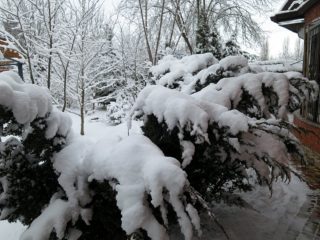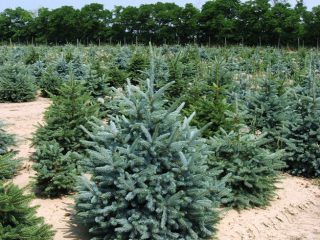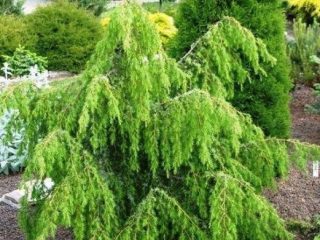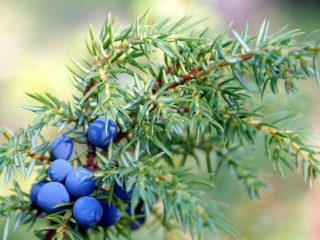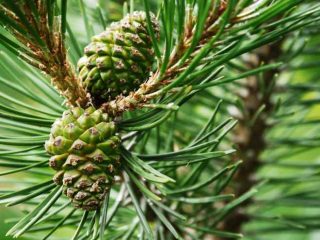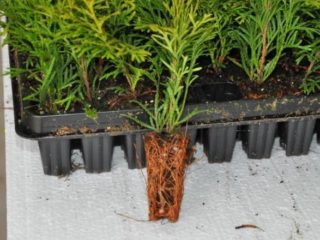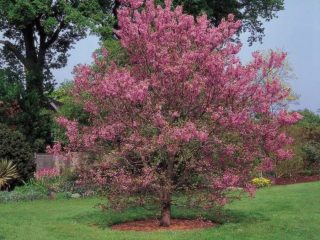Content
Paulownia tomentosa is a broad-leaved deciduous tree that is a representative of the family and species of the same name. The main name for the culture was given by the Germans in honor of the daughter of Emperor Paul I and the Queen of the Netherlands - Anna Pavlovna. The plant received its specific epithet because of the felt covering on the back of the leaves.
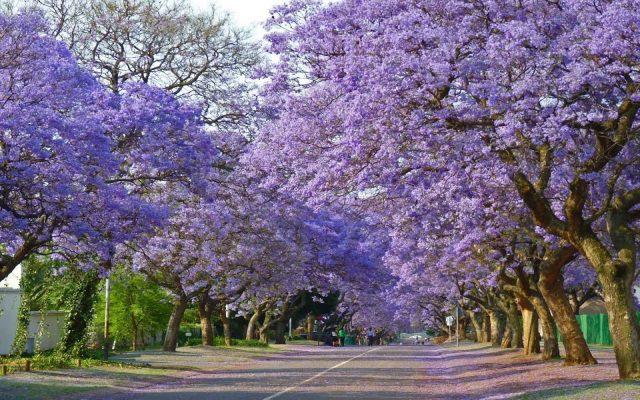
Paulownia tomentosa has been widely cultivated since the 18th century.
Description of Paulownia tomentosa
Paulownia is valued for its accelerated growth rate, luxurious crown and high decorative qualities. Therefore, it is considered a valuable garden crop. Other names of the plant are Adam's tree, Imperial tree, Paulownia imperialis, Empress tree, Princess tree, Mao pao tong, Kiri.
This is a tall tree, the height of which under favorable conditions can reach 20 m or more. The crown of Paulownia tomentosa is spreading, spherical or slightly oval. The trunk diameter is 0.6 m, and sometimes reaches 1 m.The bark on the trunk and main branches is gray with a slight brown tint. Its surface is smooth except for rare longitudinal grooves.
The leaves are a real decoration of the tree and provide dense shade under it. The plates of paulownia are large and solid. They have a heart shape, a pointed top and most often a smooth edge. The length and width of the leaves reaches 30-40 cm. The color of the plates is rich green. The leaves are pubescent on top and tomentose on the underside.
The tree is especially decorative due to its paniculate inflorescences, which bloom in the spring before the leaves appear or at the beginning of the growing season. Their length reaches 30 cm. They consist of numerous bell-shaped flowers, up to 6 cm in diameter, of a pale purple hue. When opened, the buds emit a pleasant aroma. Paulownia tomentosa buds begin to form at the end of summer.
The tree produces broadly ovoid fruit boxes that ripen by October. Inside they contain winged seeds from 1200 to 2300 pieces. When the fruit ripens, the shell cracks and the contents are carried away by the wind.
Winter hardiness of Paulownia tomentosa
Paulownia tomentosa has an average level of frost resistance. It can withstand short-term temperature drops down to -27 °C. However, the tree acquires stability as it matures. Also, the frost resistance of a crop directly depends on the care and correct location chosen for it on the site.
Where does paulownia tomentosa grow?
Under natural conditions, the culture grows in many provinces of China, but has a wide cultivation area.The plant is grown in the USA, Japan, Ukraine, Korea, and Europe. Paulownia tomentosa is also common in the southern regions of Russia.
The plant prefers open areas and slopes. Paulownia is undemanding to soil, but develops better on loamy soils rich in organic matter.
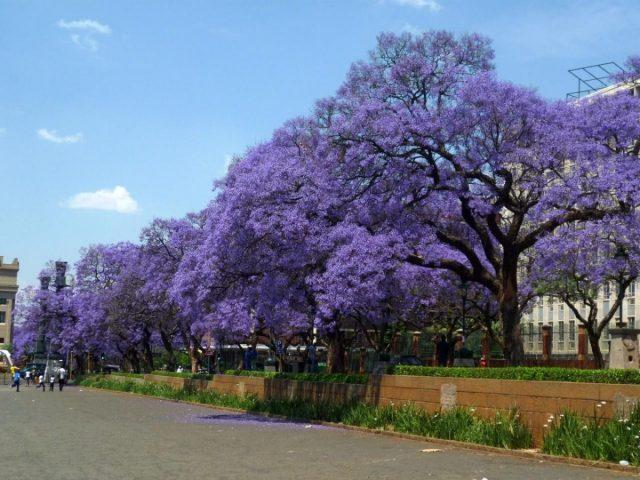
The lifespan of paulownia tomentosa is more than a hundred years.
Methods of application
The Paulownia tomentosa plant is widely used not only in decorative landscaping. Culture is technical. Its seeds contain oil, which in Japan is used to impregnate certain types of paper, as well as in the process of creating varnish.
Felt paulownia wood is also valuable. It has a low humidity level of 10-12%, so it is not very susceptible to rotting. Wood from the tree is widely used in the production of furniture, musical instruments, sports equipment, souvenirs, and in shipbuilding and aircraft construction.
The leaves of the plant have a unique chemical composition. The protein content in them reaches 20%. The taste of the leaves resembles clover and alfalfa, therefore they are a valuable feed in livestock farming. Flowers are used as aromatic raw materials.
Paulownia tomentosa, thanks to its intensive growth and development of the root system, helps to quickly improve the fertility of soils damaged after fires and landslides. The enrichment of the soil with organic components is facilitated by its green mass, which, after leaf fall, quickly turns into nutrients.
Advantages and disadvantages
This culture has many advantages, which is why it has become widespread in countries with favorable climatic conditions for its cultivation.However, wood also has certain disadvantages that must be taken into account.
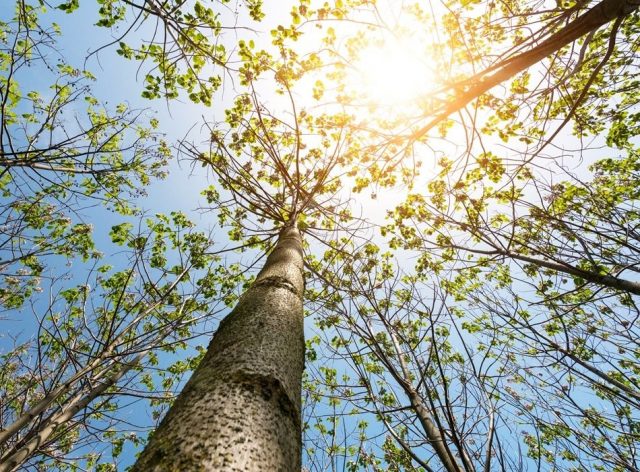
Paulownia tomentosa wood matures at the age of 8-9 years
Main advantages:
- accelerated growth rate;
- high decorative qualities;
- withstands short-term drought;
- is resistant to diseases and pests;
- wide application;
- easily tolerates gas and dust in the air;
- low maintenance;
- easy to reproduce.
Flaws:
- average frost resistance;
- requires good lighting;
- needs sufficient free space.
Features of growing paulownia tomentosa
Growing paulownia tomentosa does not cause difficulties even for novice gardeners. The tree does not require complex care; it is enough to adhere to standard rules of agricultural technology. Therefore, you just need to know how best to carry out care activities.
Landing rules
It is recommended to plant a tree in the spring before the growing season begins. For paulownia, you need to choose a place that is well lit throughout the day, where the groundwater level is at least 3 m.
The plant prefers loamy and sandy loam soil with a neutral acidity level. You can plant seedlings of any age, since the crop tolerates transplantation well and quickly adapts to a new location.
For planting, you need to prepare a hole up to 1 m deep and 70 cm wide. It is recommended to lay drainage in a layer of 10 at the bottom, and fill the rest of the space with a mixture of turf, sand and humus in a 2:1:1 ratio. Planting should be carried out according to the standard scheme. At the end of the process, the root collar of the paulownia should be at soil level.
Care instructions
A young tree needs regular watering. Moisturizing should be done 1-2 times a week. During hot periods of the year, the root circle of the tree should be covered with mulch to reduce evaporation. From the third year of life, the tree no longer needs watering, since it is able to provide itself with moisture.
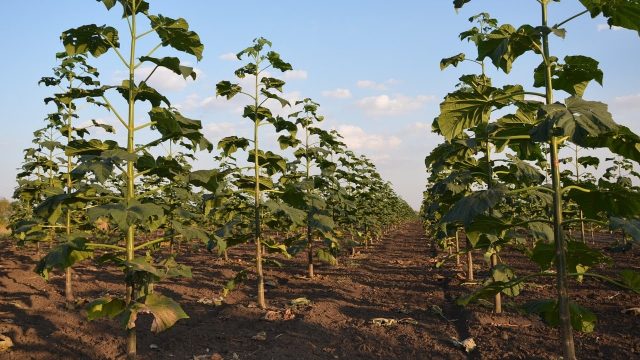
Paulownia tomentosa does not tolerate stagnation of moisture in the soil.
Caring for paulownia tomentosa involves periodic feeding. For this purpose in the spring it is recommended to use chicken manure 1:15 or mullein 1:10. In the absence of organic matter, the tree can be fertilized with nitroammophos at the rate of 70-150 g per plant.
It is recommended to feed paulownia tomentosa in August. This promotes abundant flowering in the next season and increases the frost resistance of the crop. During this period, you can use potassium monophosphate at the rate of 10 g per bucket of water.
Since paulownia belongs to the category of low-branching trees, the formation of a crown at an early stage of its development is a mandatory procedure. It is necessary to trim the lower side shoots in early spring for 3-4 years after planting. This way the crown start level is controlled.
In the future, pruning is carried out only to clean the tree from broken and damaged branches.
When growing paulownia tomentosa in the Moscow region, as well as other central regions, the seedling must be insulated for the winter during the first three years. To do this in the fall, it is necessary to lay a layer of humus in the root circle up to 10 cm, and wrap the crown with agrofibre and fix it.
Reproduction methods
The crop can be propagated by seeds and cuttings. When using the first method, you need to sow in containers with a nutrient mixture on top of moist soil and cover them with glass.For successful germination of Paulownia tomentosa seeds, it is necessary to provide a temperature of +23 ° C and lighting 12 hours a day.
If all conditions are met, seedlings appear after two weeks. After this, you need to periodically water and ventilate the seedlings. When the sprouts become stronger, they need to be adapted to external conditions and then transplanted into separate containers. You can plant seedlings in open ground when they are old enough.
The method of propagation by cuttings is recommended to be used in late spring and early summer. To do this, it is necessary to cut the tops of the shoots 15-20 cm long. The lower part of them must be cleared of leaves, and the sections must be powdered with a root former. After this, the cuttings must be planted in a mixture of turf, humus and sand, taken in equal proportions. For better rooting, you need to make a mini-greenhouse, ensure regular soil moisture as needed and a temperature of +25 ° C. Plants can be planted in a permanent place after a year.
Paulownia felt in landscape design
This culture is a real boon for quick and low-cost landscaping of areas. Paulownia is used as an avenue tree, as well as in single plantings. But in order for the tree to develop well, it must be planted at a distance of 3 m from other plants.
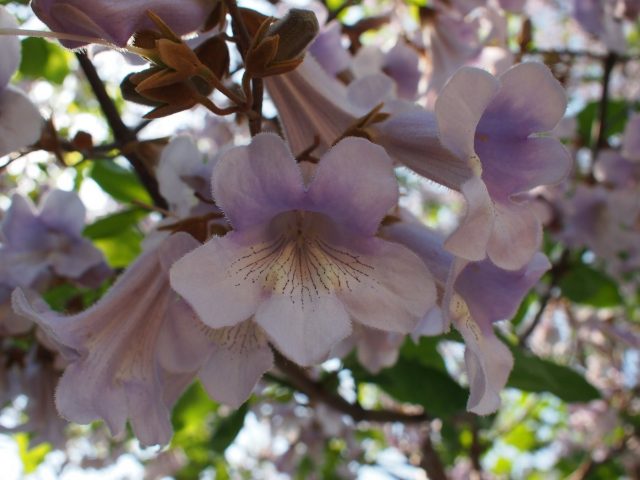
The tree blooms 4-5 years after planting
Conclusion
Paulownia tomentosa is a unique crop whose popularity has been growing in recent years. Its main advantages are accelerated growth and a presentable appearance throughout the season.Therefore, the increased interest of landscape designers in this tree is completely justified; moreover, it does not suffer from air pollution.
Reviews of paulownia tomentosa
